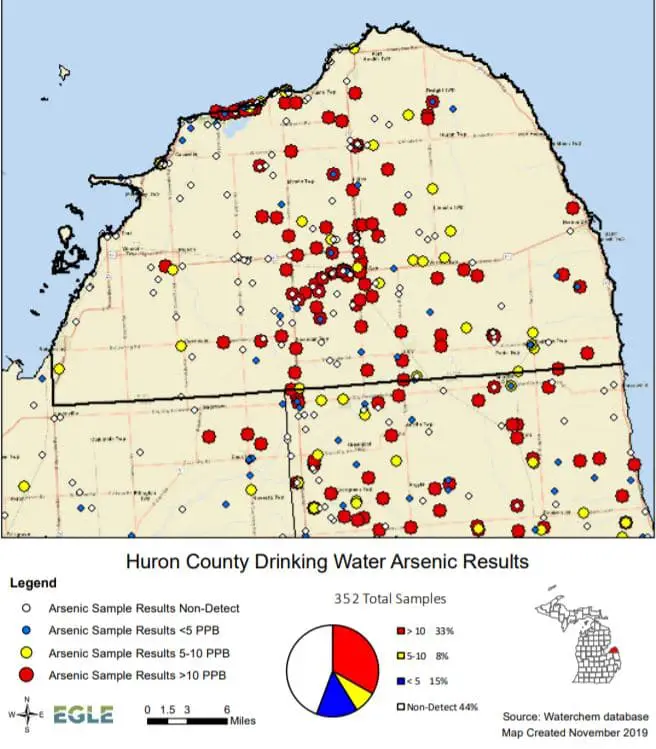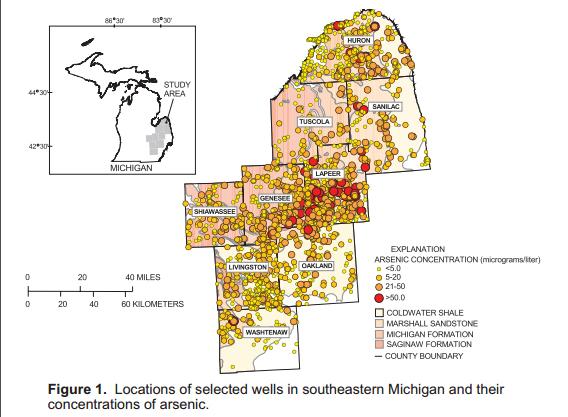Before you drink another drop of water from your well in Michigan’s Thumb Thumb read this report from Michigan Public Radio about arsenic in Michigan water. Interactive maps show the Thumb region is one of the worst in the state for having arsenic in well water.
There are two types of arsenic; organic and inorganic. Organic arsenic exists in the food we eat. Some fish, shrimp, shellfish, and other seafood may contain significant amounts of organic arsenic, the less toxic form.
Inorganic arsenic is more harmful and tends to come from groundwater. Its harmful effects can come from drinking it and depends on the amount and length of exposure and individual sensitivity. Inorganic arsenic in Michigan well water is naturally occurring but can be carcinogenic if consumed. Tainted water can still be used for some activities such as showering and watering the lawn, but officials have warned of the effects of long-term exposure through drinking and cooking.
Huron County Arsenic Water Sample Hotspots 2019

According to the EPA, arsenic has been linked to several different types of cancer, partial paralysis and blindness. If you discover that your water has arsenic in utilizing a reverse osmosis filter to mitigate the problem. Prices start at about $200.
Testing Your Well for Arsenic
To test well water for arsenic, call the Michigan Department of Environment, Great Lakes, and Energy (EGLE), Drinking Water Laboratory at 517-335-8184, or any commercial laboratory certified to test for arsenic. Your local health department can provide you with a list of accredited laboratories or make arrangements to test your water by the EGLE Laboratory.
Contact the laboratory to obtain water sample collection bottles and instructions for sample collection. You can find the address and telephone number for your local health department in the government section of your local phone book or at www.malph.org.
What to do if you have Arsenic in your Drinking Water
Contact your local health department to discuss solutions that have worked in your area. There are several options available to reduce exposure to arsenic in drinking water, including:
Connecting the home to a public (municipal) water supply (if available). Public water supplies are required to meet the arsenic maximum contaminant level (MCL).
Replacing a well or modifying a well to draw water from an aquifer with lower levels of arsenic may be possible. Contact your local health department before replacing or modifying your water well to discuss whether this is a viable option.
Using bottled water for drinking and cooking. Commercially prepared bottled water for sale meets the arsenic MCL.
Treating drinking water with point-of-use reverse osmosis (RO) or arsenic adsorption media cartridge filters is the most effective and practical treatment method for residential use. Point-of-entry treatment that treats all water entering the home is also an option. Before installing a water treatment system, owners should carefully research the treatment system’s effectiveness for arsenic reduction and its operational and maintenance requirements. Generally, arsenic adsorption media point-of-entry treatment is used with water low in iron, while oxidation/filtration (greensand iron removal) is used with water high in iron. Water softeners and activated carbon filters do not reduce arsenic levels effectively. A treatment unit certified by NSF International for arsenic reduction and installed to their specifications is recommended. Information is available at www.nsf.org.
Sources for More Information
Arsenic in Michigan Water, Related Reading
Michigan’s arsenic problem is among the worst in the nation. Here’s why that matters.|Michigan Radio – Arsenic occurs naturally in rock, and it can get into groundwater. Michigan is one of a handful of states with unusually high arsenic concentrations in groundwater.
5 Things I Learned During the Flint Water Crisis – In January 2016 Groups and individuals from all over the United States flew into Flint Bishop Airport or drove hours to donate their time and skills to alleviate the disaster of lead contamination with the Flint Water Crisis.
Lies and Half-Truths of Stealing Great Lakes Water – The blogosphere and news sites have been bristling that former President of the United States, Barack Obama, allowed water from the Great Lakes region to be pumped and sold to China. It’s a Lie.





